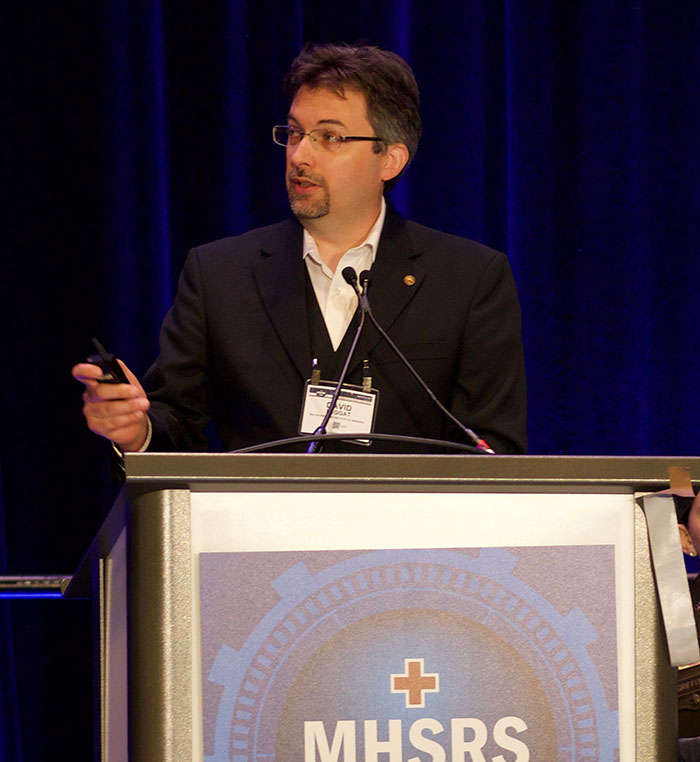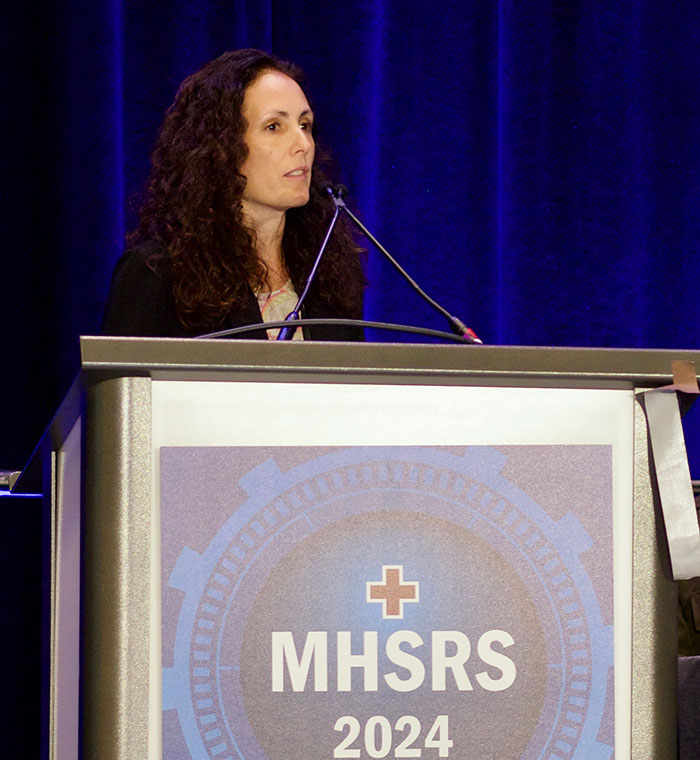WRAIR Researchers Discuss Vaccine Innovations at MHSRS

KISSIMMEE, Fla. — Researchers from the U.S. Army Medical Research and Development Command's Walter Reed Army Institute of Research shared the results of their latest research into new vaccines and platforms for vaccine delivery for the Warfighter at the 2024 Medical Health System Research Symposium in Kissimmee, Florida, Aug. 27.
The findings highlighted the work being conducted at WRAIR to develop innovative approaches for preventing and treating infectious diseases of national security importance to the U.S. military, including HIV, malaria and coronaviruses.
As part of a panel session titled "An Ounce of Prevention: Next Generation Vaccines and Passive Immunoprophylaxis to Enhance Warfighter Readiness," two researchers from the Military HIV Research Program, part of WRAIR's Center for Infectious Disease Research, discussed the results of recent studies that tested innovative new therapeutics designed to protect Warfighters from HIV infection and reduce its global impact.
Dr. David Leggat, a research microbiologist, reviewed the results of a recent study to determine the optimum does of a new variant of the Army Liposome Formulation family of adjuvants, which are chemical compounds added to a vaccine to stimulate the body's immune response against toxins, allergens and other harmful substances.
The research team tested the new variant, called ALFQ, at concentrations of 50, 100 and 200 micrograms, in combatting HIV infection. The researchers administered the vaccine to study participants in a series of three doses. The study showed that, although the 50μg concentration tended to produce a lower level of antibodies after the first and second dose, following the third dose the levels of antibodies in all three concentrations were the same. The study also showed that the vaccine is safe and well-tolerated, with few noticeable side effects exhibited by study participants. These results are a crucial step toward eventually deploying ALFQ as an HIV vaccine to protect Warfighters and civilians.

In partnership with the Henry Jackson Foundation for the Advancement of Military Medicine, CIDR researchers have also tested the effectiveness of vaccines containing the AFLQ adjuvant in fighting other diseases, including malaria, SARS-CoV-2 and the bacteria that causes diarrhea, called Campylobacter. Dr. Essie Komla reported that recent studies of the adjuvant found it to be both safe and highly potent in treating all three diseases. Study participants reported mild to moderate reactions such as pain at the injection site, and no serious adverse side effects. In all three studies, the AFLQ vaccine induced immune responses that Komla described as robust. She explained that three Phase I clinical trials involving AFLQ vaccines are currently underway — two testing HIV vaccines, and one testing a vaccine against Campylobacter.
CIDR is particularly interested in the applicability of ALFQ in combatting malaria because of its significant impact on Warfighter readiness. Every year, medical evacuation and care of service members with malaria are estimated to cost over $4 million per year and result in over 20,000 lost work hours.
During the panel session, Dr. Caroline Subra discussed the promising outcomes of a study of a new prophylactic HIV vaccine that uses a potent antibody called 10E8.4/iMab. The antibody interacts with a protein called CD4, which plays a crucial role in activating of specialized cells that enhance the body's immune response, called T cells. By triggering the body's immune response to HIV, the vaccine would be able to provide immediate and long-lasting protection against infection.
When tested on simian models, a single intravenous dose of the vaccine containing the 10E8.4/iMab antibody was found to effectively prevent viral infection. One promising application of the vaccine would be patients who are about to undergo high-risk blood transfusions, as a way to minimize their risk of HIV infection without the need for ongoing drug therapy after the transfusion.

Another area of research at CIDR is the development of next-generation vaccines that target specific immune responses, which differ from traditional vaccines that stimulate the body's entire immune system. Unlike the shotgun approach commonly found in vaccines today, these new vaccines are akin to snipers, tailored to attack a particular infectious parasitic, viral, or bacterial target with a high degree of effectiveness.
Dr. Shelby Foor, a researcher in CIDR's Structural Vaccinology Laboratory, shared the results of a study that tested a novel vaccine delivery platform called an epitope disk nanoparticle. Epitopes are regions on the surface of toxic substances that trigger the body's immune response. Stimulating the epitope of a harmful substance such as a bacteria or foreign blood cell causes the body to react and destroy the invader. Foor explained that a disk-shaped nanoparticle is more effective at delivering epitope stimulants because they avoid "snagging" on other parts of the invading substance's molecular structure.
In a clinical study, Foor's team tested epitope disk nanoparticles against malaria and found it to be highly effective in fighting the disease, and work is underway to develop versions capable of targeting a wide range of viral and bacterial agents, including the Chikungunya virus and bacteria that cause pneumonia and antibiotic-resistant infections. Foor explained that a standardized manufacturing strategy could speed the development of medical countermeasures capable of rapid customization for future pandemics and other emerging health threats.
MHSRS, an annual four-day conference in Kissimmee, Florida, is the DOD's premier medical science research and development meeting. Over 4,000 people representing the military, academia, private industry and international partners attended the event to learn about the latest advances and initiatives in health care research related to combat casualty care, military operational medicine, clinical rehabilitation, information science, infectious diseases and radiation health effects. Many military and civilian representatives from across MRDC participated in the symposium as panelists and presenters.














